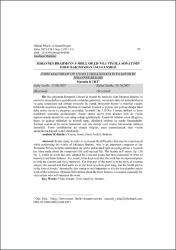| dc.contributor.author | Kurt, Mustafa | |
| dc.date.accessioned | 2022-06-29T06:55:51Z | |
| dc.date.available | 2022-06-29T06:55:51Z | |
| dc.date.issued | 2021 | en_US |
| dc.identifier.citation | Kurt, M. (2021). Johannes Brahms’ın f-moll no:1 op:120 viyola sonatının form bakımından incelenmesi. Balkan Müzik ve Sanat Dergisi , 3 (2) , 97-113 . | en_US |
| dc.identifier.uri | http://dspace.trakya.edu.tr/xmlui/handle/trakya/8073 | |
| dc.description.abstract | Bu çalışmada Romantik Dönem’in önemli bir bestecisi olan Johannes Brahms’ın eserlerini icra ederken yaşanabilecek zorlukları gidermek, eserlerinin daha iyi anlaşılabilmesi ve genç sanatçılara ışık olması amacıyla ilk olarak bestecinin hayatı ve müzikal yaşamı hakkında araştırma yapılmış, Brahms’ın esasında klarinet ve piyano için yazmış olduğu fakat daha sonra viyola ve piyanoya uyarladığı Fa minör Op. 120 No. 1 sonatı tarihsel ve form özellikleri açısından incelenmiştir. Sonuç olarak eserin hem klarinet hem de viyola repertuvarında önemli bir yere sahip olduğu görülmüştür. Eserin ilk bölümü sonat allegrosu, ikinci ve üçüncü bölümleri üç bölmeli şarkı, dördüncü bölümü ise rondo formundadır. Tarihsel açıdan da bu sonat, bestecinin son oda müziği eseri olması bakımından oldukça önemlidir. Form özelliklerine ait detaylı bilgiler, eseri yorumlayacak olan viyola sanatçılarına kaynak teşkil etmektedir. | en_US |
| dc.description.abstract | In this study, in order to overcome the difficulties that may be experienced while performing the works of Johannes Brahms, who is an important composer of the Romantic Period, to better understand his works and to shed light on young artists, a research has been made about the composer's life and musical life. The Sonata in F minor Op. 120 No. 1, which he wrote but later adapted for viola and piano, has been examined in terms of historical and form features. As a result, it has been seen that the work has an important place in both the clarinet and viola repertoire. The first part of the piece is in the form of a sonata
allegro, the second and third parts are in the form of a three-part song, and the fourth part is in the form of rondo. Historically, this sonata is very important as it is the last chamber music work of the composer. Detailed information about the form features is a source especially for viola artists who will interpret the work. | en_US |
| dc.language.iso | tur | en_US |
| dc.publisher | Trakya Üniversitesi | en_US |
| dc.relation.ispartof | Balkan Müzik ve Sanat Dergisi | en_US |
| dc.identifier.doi | 10.47956/bmsd.994596 | en_US |
| dc.rights | info:eu-repo/semantics/openAccess | en_US |
| dc.subject | Viyola | en_US |
| dc.subject | Sonat | en_US |
| dc.subject | Form Analizi | en_US |
| dc.subject | Brahms | en_US |
| dc.subject | Viola | en_US |
| dc.subject | Sonata | en_US |
| dc.subject | Form Analysis | en_US |
| dc.title | Johannes Brahms’ın f-moll no:1 op:120 viyola sonatının form bakımından incelenmesi | en_US |
| dc.title.alternative | Form analysis of op.120 no.1 viola sonata in fa minor by Johannes Brahms | en_US |
| dc.type | article | en_US |
| dc.authorid | 0000-0002-6204-6907 | en_US |
| dc.department | Seçiniz | en_US |
| dc.identifier.volume | 3 | en_US |
| dc.identifier.issue | 2 | en_US |
| dc.identifier.startpage | 97 | en_US |
| dc.identifier.endpage | 113 | en_US |
| dc.relation.publicationcategory | Makale - Ulusal Hakemli Dergi - Kurum Öğretim Elemanı | en_US |
| dc.institutionauthor | Kurt, Mustafa | |


















